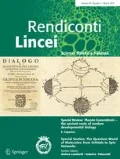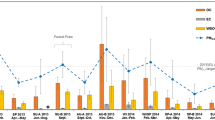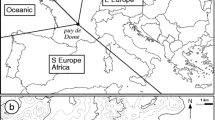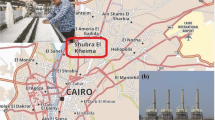Abstract
We investigated the elemental composition and water-soluble-organic compounds (WSOC) present in size-segregated airborne particulate matter to better understand: (1) the distribution of the water-soluble fraction of trace elements (TE), rare earth elements (REE) and WSOCs among different particulate sizes, and (2) the transport processes of aerosol towards the Arctic zone. Samples were collected at Ny-Alesund in the Svalbard Islands (78°55′07″N, 11°53′30″E) from 19 April to 14 September 2010. Water-soluble TE and REE were measured with the aim of recognising reliable tracers of specific sources, which may prove crucial in cost-effective strategies of air pollution control. The TE and REE content, especially in the finest fractions of aerosols in remote areas, is primarily due to long-range transport. It gives valuable information on the global circulation and on the contribution of human activities to aerosol composition (Birmili et al. in Environ Sci Technol 40:1144–1153, 2006; Fernández-Espinosa et al. in Atmos Environ 38:873–886, 2004; Song et al. in Atmos Environ 35:5277–5286, 2001). On the same samples, we also determined water-soluble organic tracers as specific source indicators: levoglucosan and methoxyphenols from biomass burning, acrylamide from anthropogenic origin and amino acids from primary production. These results were discussed in previous papers (Scalabrin et al. in Atmos Chem Phys 12:10453–10463, 2012; Zangrando et al. in Environ Sci Technol 47:8565–8574, 2013).




Similar content being viewed by others
References
Baker RGA, Rehkämper M, Hinkley TK, Nielsen SG, Toutain JP (2009) Investigation of thallium fluxes from subaerial volcanism-Implications for the present and past mass balance of thallium in the oceans. Geochim Cosmochim Acta 73:6340–6359. doi:10.1016/j.gca.2009.07.014
Barbaro E et al (2015) Free amino acids in Antarctic aerosol: potential markers for the evolution and fate of marine aerosol Atmos. Chem Phys 15:5457–5469
Birmili W, Allen AG, Bary F, Harrison RM (2006) Trace metal concentrations and water solubility in size-fractionated atmospheric particles and influence of road traffic. Environ Sci Technol 40:1144–1153. doi:10.1021/es0486925
Canepari S, Pietrodangelo A, Perrino C, Astolfi ML, Marzo ML (2009) Enhancement of source traceability of atmospheric PM by elemental chemical fractionation. Atmos Environ 43:4754–4765. doi:10.1016/j.atmosenv.2008.09.059
Christian TJ, Yokelson R, Cárdenas B, Molina L, Engling G, Hsu S-C (2010) Trace gas and particle emissions from domestic and industrial biofuel use and garbage burning in central Mexico Atmos. Chem Phys 10:565–584
Fernández-Espinosa AJ, Rodríguez MT, Álvarez FF (2004) Source characterisation of fine urban particles by multivariate analysis of trace metals speciation. Atmos Environ 38:873–886. doi:10.1016/j.atmosenv.2003.10.046
Friedman M (2003) Chemistry, biochemistry, and safety of acrylamide. A review. J Agric Food Chem 51:4504–4526
Gao Y, Arimoto R, Duce R, Lee D, Zhou M (1992) Input of atmospheric trace elements and mineral matter to the Yellow Sea during the spring of a low-dust year. J Geophys Res Atmos 97:3767–3777
Hinkley TK (1991) Distribution of metals between particulate and gaseous forms in a volcanic plume. Bull Volc 53:395–400
Hinkley TK, Le Cloarec MF, Lambert G (1994) Fractionation of families of major, minor, and trace metals across the melt-vapor interface in volcanic exhalations. Geochim Cosmochim Acta 58:3255–3263. doi:10.1016/0016-7037(94)90053-1
Hodzic A, Wiedinmyer C, Salcedo D, Jimenez J (2012) Impact of trash burning on air quality in Mexico City. Environ Sci Technol 46:4950–4957
Iijima A et al (2009) Clarification of the predominant emission sources of antimony in airborne particulate matter and estimation of their effects on the atmosphere in Japan. Environ Chem 6:122–132
Konovalov IB, Beekmann M, Kuznetsova IN, Yurova A, Zvyagintsev AM (2011) Atmospheric impacts of the 2010 Russian wildfires: integrating modelling and measurements of an extreme air pollution episode in the Moscow region. Atmos Chem Phys 11:10031–10056. doi:10.5194/acp-11-10031-2011
Landsberger S, Vermette SJ, Barrie LA (1990) Multielemental composition of the Arctic aerosol. J Geophys Res Atmos 95:3509–3515. doi:10.1029/JD095iD04p03509
Mace KA, Artaxo P, Duce RA (2003) Water-soluble organic nitrogen in Amazon Basin aerosols during the dry (biomass burning) and wet seasons. J Geophys Res Atmos 108:D16
Maenhaut W, Cornille P, Pacyna JM, Vitols V (1989) Trace element composition and origin of the atmospheric aerosol in the Norwegian arctic. Atmos Environ 1967 23:2551–2569. doi:10.1016/0004-6981(89)90266-7
Mielonen T et al (2012) Biomass burning aerosols observed in Eastern Finland during the Russian wildfires in summer 2010-Part 2: remote sensing. Atmos Environ 47:279–287
Oros DR, Simoneit BRT (2001a) Identification and emission factors of molecular tracers in organic aerosols from biomass burning. Part 1: Temperate climate conifers. Appl Geochem 16:1513–1544. doi:10.1016/S0883-2927(01)00021-X
Oros DR, Simoneit BRT (2001b) Identification and emission factors of molecular tracers in organic aerosols from biomass burning. Part 2: Deciduous trees. Appl Geochem 16:1545–1565. doi:10.1016/S0883-2927(01)00022-1
Oros DR, Abas MRB, Omar NYMJ, Rahman NA, Simoneit BRT (2006) Identification and emission factors of molecular tracers in organic aerosols from biomass burning: part 3. Grasses Appl Geochem 21:919–940. doi:10.1016/j.apgeochem.2006.01.008
Pacyna JM, Vitols V, Hanssen JE (1984) Size-differentiated composition of the Arctic aerosol at Ny-Ålesund, Spitsbergen. Atmos Environ 18:2447–2459
Petersen GN (2010) A short meteorological overview of the Eyjafjallajökull eruption 14 April–23 May 2010. Weather 65:203–207. doi:10.1002/wea.634
Portin H et al (2012) Biomass burning aerosols observed in Eastern Finland during the Russian wildfires in summer 2010-Part 1: in-situ aerosol characterization. Atmos Environ 47:269–278
Scalabrin E, Zangrando R, Barbaro E, Kehrwald NM, Gabrieli J, Barbante C, Gambaro A (2012) Amino acids in Arctic aerosols Atmos. Chem Phys 12:10453–10463. doi:10.5194/acp-12-10453-2012
Schmeltz I, Hoffmann D (1977) Nitrogen-containing compounds in tobacco and tobacco smoke. Chem Rev 77:295–311
Simoneit BRT (2002) Biomass burning: a review of organic tracers for smoke from incomplete combustion. Appl Geochem 17:129–162. doi:10.1016/S0883-2927(01)00061-0
Song X-H, Polissar AV, Hopke PK (2001) Sources of fine particle composition in the northeastern US. Atmos Environ 35:5277–5286. doi:10.1016/S1352-2310(01)00338-7
Tekkeli SEK, Önal C, Önal A (2012) A review of current methods for the determination of acrylamide in food products. Food Anal Methods 5:29–39
Toscano G, Gambaro A, Moret I, Capodaglio G, Turetta C, Cescon P (2005) Trace metals in aerosol at Terra Nova Bay, Antarctica. J Environ Monitor 7:1275–1280
Turetta C, Cozzi G, Barbante C, Capodaglio G, Cescon P (2004) Trace elements determination in seawater by ICP-SFMS coupled with a micro-flow nebulization/desolvation. Anal Bioanal Chem 380:258–268
Wedepohl KH (1995) The composition of the continental crust. Geochim Cosmochim Acta 59:1217–1232
Zangrando R, Gambaro A, Pieri SD, Gabrieli J, Barbaro E, Barbante C, Cescon P (2012) Acrylamide determination in atmospheric particulate matter by high-performance liquid chromatography/electrospray ionisation tandem mass spectrometry. Int J Environ 92:1150–1160
Zangrando R et al (2013) Molecular Markers of Biomass Burning in Arctic Aerosols. Environ Sci Technol 47:8565–8574. doi:10.1021/es400125r
Zangrando R, Barbaro E, Vecchiato M, Kehrwald NM, Barbante C, Gambaro A (2016) Levoglucosan and phenols in Antarctic marine, coastal and plateau aerosols. Sci Total Environ 544:606–616
Acknowledgments
This paper is a contribution to the PRIN 2007L8Y4NB Project, funded by Italian MURST and supported by EARLY human IMPACT project “How long have human activities been affecting the climate system?” (Project No. 267696). The logistic support of the National Research Council—Department of Earth System Science and Environmental Technologies (CNR-DTA) is gratefully acknowledged. The authors thank Elga Lab water, High Wycombe UK for supplying the pure water systems used in this study.
Author information
Authors and Affiliations
Corresponding author
Additional information
This peer-reviewed article is a result of the multi and interdisciplinary research activities based at the Arctic Station “Dirigibile Italia”, coordinated by the “Dipartimento Scienze del Sistema Terra e Tecnologie per l’Ambiente” of the National Research Council of Italy.
Rights and permissions
About this article
Cite this article
Turetta, C., Zangrando, R., Barbaro, E. et al. Water-soluble trace, rare earth elements and organic compounds in Arctic aerosol. Rend. Fis. Acc. Lincei 27 (Suppl 1), 95–103 (2016). https://doi.org/10.1007/s12210-016-0518-6
Received:
Accepted:
Published:
Issue Date:
DOI: https://doi.org/10.1007/s12210-016-0518-6




